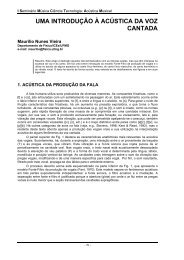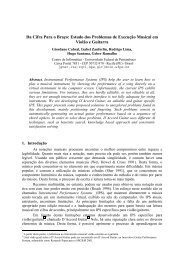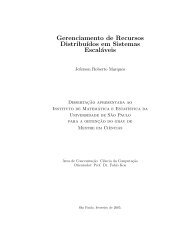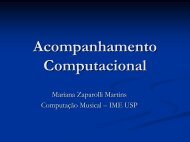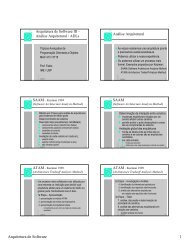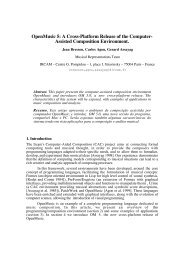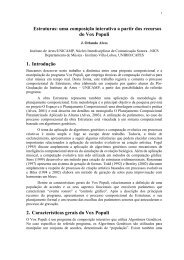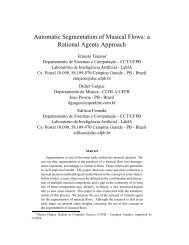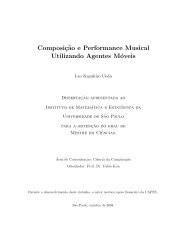Comparative study of measured acoustic parameters in concert halls ...
Comparative study of measured acoustic parameters in concert halls ...
Comparative study of measured acoustic parameters in concert halls ...
You also want an ePaper? Increase the reach of your titles
YUMPU automatically turns print PDFs into web optimized ePapers that Google loves.
C 80 - rear<br />
Guarnieri<br />
São Pedro<br />
dB<br />
14<br />
12<br />
10<br />
8<br />
6<br />
4<br />
2<br />
0<br />
-2<br />
-4<br />
Municipal<br />
125 250 500 1000 2000 4000<br />
Hz<br />
Figure 15: rear audience RT 60 Figure 16: rear audience C 80<br />
C80 Guarnieri ma<strong>in</strong> floor<br />
10<br />
mean IR<br />
<strong>parameters</strong><br />
IRs <strong>parameters</strong><br />
average<br />
8<br />
dB<br />
6<br />
4<br />
2<br />
0<br />
125 250 500 1000 2000 4000<br />
Hz<br />
Figure 17: bass ratios and treble ratios<br />
Figure 18: compar<strong>in</strong>g statistics ways<br />
We have noticed that the patterns <strong>of</strong> the IRs have changed considerably for the different<br />
positions <strong>of</strong> measurement. Generally we have got short and dry IRs for stage measurements<br />
(<strong>in</strong> part because <strong>of</strong> the directivity <strong>of</strong> the source) when compared with the measurements made<br />
<strong>in</strong> the center <strong>of</strong> the audience, partly due to the higher amount <strong>of</strong> reflection. It was observed –<br />
and it is a desirable characteristic <strong>in</strong> the work <strong>of</strong> the conductor – that the values <strong>of</strong> Clarity and<br />
def<strong>in</strong>ition <strong>in</strong> the stage are bigger than those for the rest <strong>of</strong> the theater. The ITDG values, as<br />
one should expect, are lower <strong>in</strong> the stage (average <strong>of</strong> 4 ms) than <strong>in</strong> the audience (average <strong>of</strong><br />
13 ms). The measurements <strong>in</strong> the back <strong>of</strong> the audience, the IRs <strong>in</strong>dicate a higher diffusion<br />
and lower values for the direct/reverberant energy ratio. We could also notice dist<strong>in</strong>ct timber<br />
colorations, but we will return to that later <strong>in</strong> this text. As we changed the measurement<br />
positions we could clearly perceive a “natural equalization” <strong>of</strong> the sounds, both <strong>in</strong> the<br />
calculated <strong>parameters</strong> and <strong>in</strong> the listen<strong>in</strong>g <strong>of</strong> the anechoic samples.<br />
The architectural characteristic <strong>of</strong> the theaters can help to understand the graphs above. The<br />
Teatro Municipal holds 1500 people <strong>in</strong> a Italian shaped audience, has a significant part <strong>of</strong> the<br />
floor covered by carpets, and <strong>of</strong>fers 4 floors for the audience, hav<strong>in</strong>g therefore a much higher<br />
ceil<strong>in</strong>g than the others. The Teatro São Pedro, as well as the Anfiteatro Camargo Guarnieri,<br />
holds about 700 people and both <strong>of</strong> them are also used for dramatic arts. The São Pedro has a<br />
shell shaped audience while de Guarnieri is basically rectangular. The superficies are<br />
significantly different: predom<strong>in</strong>antly masonry <strong>in</strong> the São Pedro, and wood <strong>in</strong> the Camargo



